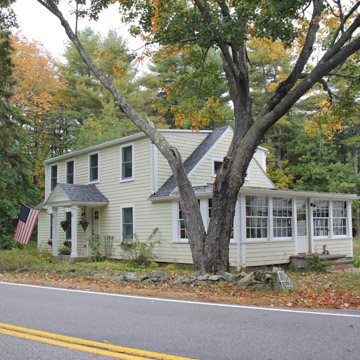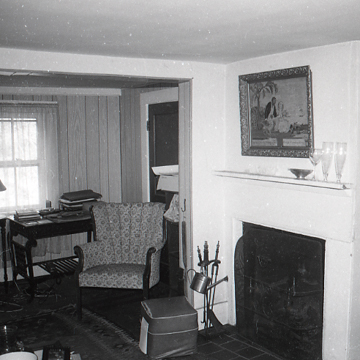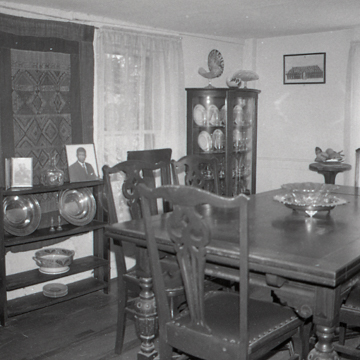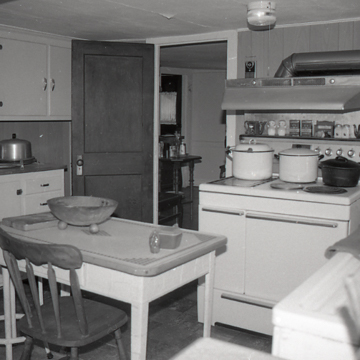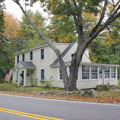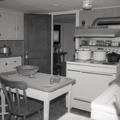Rock Rest was a guesthouse for African American travelers run by Clayton and Hazel Sinclair near the affluent town of Kittery, Maine, from about 1946 to 1977. Because of Hazel's careful stewardship, Rock Rest is perhaps the best documented business of its kind from the period of segregated accommodations.
Hazel Colbert and Clayton Sinclair married in 1937. They had met the year before, traveling with their respective employers to summer homes near Kittery—Clayton as a chauffeur and Hazel as a ladies’ maid. The summer following their marriage, they elected to remain in Maine when their employers returned to New York City, and in 1938, they bought a small deteriorating residential building in Kittery Point. The building was a timber-frame, Cape-style residence that likely dated to the 1880s, and the Sinclairs spent the next two years renovating and expanding the house, moving into the building in 1940.
Rock Rest’s origins as a residence is reflected in its modest domestic character and materials, as well as a separate guesthouse, outbuildings, and landscape elements. The main house is a one-and-a-half-story, L-shaped, wood-frame structure clad in asbestos shingles with an asphalt shingled roof. An enclosed porch runs the length of the building’s north facade, and two gabled entry porches and two exterior brick chimneys retain some of the guesthouse’s original summer home character. The interior was enlarged and modified to include a dining room and living room (each with a fireplace), a kitchen, and a small bedroom under the stairs that led to the second floor. Off the kitchen is a bathroom and family living area. The second floor contains two bedrooms under the roof dormers and a full bathroom.
The Sinclairs began to take in guests throughout World War II; these were primarily the African American staff of Kittery’s white summer visitors. They named it Rock Rest in 1946, perhaps in reference to the large bedrock outcropping on the grounds. Both Sinclairs continued to work full-time jobs in addition to operating the guesthouse.
As the reputation of the Sinclairs’ hospitality grew, the business expanded. In 1948, they replaced the existing garage with a two-car garage with guest accommodations, adding a bedroom, bathroom, and recreation room on the back. In 1954, three more bedrooms and one bath were added to the garage building. In this capacity Rock Rest could accommodate sixteen summer guests at a time, who also received breakfast and dinner in addition to their rooms. African American travelers to Maine had a handful of accommodations to choose from that were listed in travel guides such as the Green Book, but Rock Rest was not among them. However, the Sinclairs reportedly owned a copy of the Green Book and used it for their own off-season travel.
The grounds at Rock Rest included a barbecue pit and poultry building, set into a 1.8-acre landscape of flower beds, perennial shrubs, and deciduous trees. As a guesthouse in a popular summer vacation area, Rock Rest was not a stopover for travelers, but a destination, one that guests returned to year after year, according to the guest registers. Records indicate that Rock Rest hosted guests from 28 states during the active period of 1948–1977, though the majority were from New England. The guesthouse’s location on Brave Boat Harbor Road (State Highway 103), would have made it easy to find for those traveling along the coastal road between Kittery and York. In 1950, when Rock Rest had been in business for several years, African Americans made up only 1% of the state’s total population, further underscoring its role as primarily a summer accommodation for out-of-town visitors. The national interstate system, inaugurated in 1956, brought I-95 through Maine, but according to the Maine Department of Transportation, it was not fully completed until the 1980s, making the trip through the state a slow and intentional one. Rock Rest closed in 1977, and after the death of Clayton, passed to his son.
After the guesthouse closed, the family donated the papers from the business, and they are now held at the Milne Special Collections and Archives at the University of New Hampshire. Selected items from Rock Rest are in the collections of the Smithsonian’s National Museum of African American History and Culture. Although it is now a private residence, Rock Rest is included among the educational resources for African American history in New England, including the Portsmouth Black Heritage Trail.
References
Cunningham, Valerie, and Maureen Reardon. “Rock Rest: African Americans Vacationing by the Sea.” In Cross-Grained and Wily Waters: A Guide to the Piscataqua Maritime Region, edited by W. Jeffrey Bolster. Portsmouth, NH: Peter E. Randall Publisher, 2002.
Fate, Michael. “Rock Rest (1938-1976).” Black Past. Accessed May 14, 2020. https://blackpast.org/.
Mitchell, Christi A., “Rock Rest,” York County, Maine. National Register of Historic Places Inventory–Nomination Form, 2008. National Park Service, U.S. Department of the Interior, Washington, D.C.
Sinclair Family Papers, 1940-2014, MC 216, Milne Special Collections and Archives, University of New Hampshire Library, Durham, NH.














